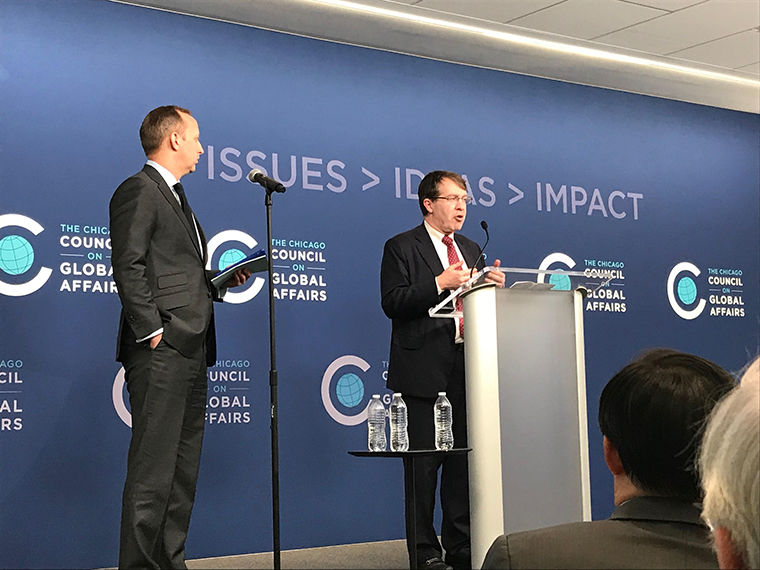South Korea caught in nuclear crossfire, generational divide, expert says
South Korea is caught in a nuclear crossfire because of U.S.–North Korean tensions, said Scott A. Snyder, a senior fellow for Korea Studies at the Council on Foreign Relations.
March 13, 2018
While many eyes are glued on a potential clash between North Korea and the U.S. as well as the prospect of a summit between the two nuclear powers, the plight of South Korea—caught between its neighbor and its ally—has received much less attention, said Scott A. Snyder, the author of “South Korea at the Crossroads: Autonomy and Alliance in an Era of Rival Powers.”
At a March 6 speech at the Chicago Council on Global Affairs, 180 N. Stetson Ave., Snyder discussed his book, released Jan. 2, and the evolving tensions between the three countries.
“Kim Jong-un has put South Korea right in the middle, between North Korea and the United States,” said Snyder, a senior fellow of Korea Studies at the Washington, D.C.-based Council on Foreign Relations. “South Korea is just in such a tough neighborhood.”
South Korea also finds itself facing the North Korean nuclear threat and has been caught up in the strained relationship between China and Japan, which puts the country at a crossroads, according to Snyder.
A more literal dividing line between North Korea and South Korea is the Demilitarized Zone at the 38th Parallel, the buffer zone that separates the two countries and “the main symbol that we have of the tragedy of Korea’s division,” he said.
The zone is also the site of talks that led to North Korea’s involvement in the recent Pyeongchang Winter Olympic Games and a proposed Korean summit between North Korean leader Kim Jong-un and South Korean President Moon Jae-in.
“This is a place that is evocative of division,” Snyder said. “Its also a place that generates potential hope.”
Snyder added that the zone symbolizes South Korea’s “generational challenges” and its shifting attitudes about reunification of the two countries.
While much of South Korea’s older generation are in favor of reunification, Snyder said a “domestic division in attitudes” in the younger generation has triggered a lack of support for a unified Korean peninsula.
“When you look at young South Koreans, they’ve grown up in a country that has always been affluent,” Karl Friedhoff, a fellow of Foreign Affairs and Public Opinion at the Chicago Council on Global Affairs, told The Chronicle. “They’ve never known a South Korea that was struggling economically, and that sets them apart from the older generations of South Koreans.”
The environment of the Olympics has also changed the discourse between North and South Korea, said Lisa Collins, a fellow with the Korea Chair at the Center for Strategic and International Studies, a Washington, D.C.-based think tank.
The “inter-Korean exchanges” seen at the Winter Games were due in part to the sports diplomacy efforts made by South Korean President Moon Jae-in, Collins said, adding that these efforts led to Kim Jong-un extending an invitation to Moon for in-person talks later this year. RC
The Winter Olympics in Pyeongchang focused the world’s attention on North Korea rather than the host country acting as a lens and “certainly a magnifier,” Friedhoff said. “The fact that North Korea suddenly—kind of out of nowhere—wanted to participate magnified that greatly.”








